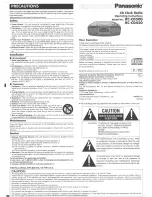
2
INSTALLATION AND CONNECTIONS
2-5
dash
dot
com
[PHONES/SP] (
Headphones/External Speaker) Jack
[MIC] connector
Controller
Set the switch on the bottom of
the Controller to “PHONES” to
use headphones and set it to
“SP” to use a speaker.
Bottom of the
controller
The transceiver accepts head-
phones with maximum 5 mW in
to an 8
Ω
impedance.
The sound level may differ, de-
pending on the headphones.
3.5(d) mm/
1
⁄
8
˝ plug
SP-35 (Optional)
A jack to connect the paddle
with electrode control on the
end terminal.
Connect to the transceiver’s
[KEY]
Jack to use the Elec-
tronic keyer (p. 2-6)
• The internal keyer is set as the
default but it can be changed in
the “keyer” Set mode (p. 4-10)
Connect to the
[CONTROLLER]
connector of the Main unit
DO NOT
connect 2 microphones at the same time.
If they are connected to the controller and the Main
unit at the same time, the both microphones will be
ON while transmitting.
OPC-589
HM-36
SM-50
• External Keypad
Control the CW memory keyer transmission from the exter-
nal keypad by connecting the control circuit to the MIC con-
nector.
Set the “Keyer” item in the “Connectors,” and set the mode to
“ON” to use the external keypad. (p. 17-25)
• Data transmission (AFSK)
Connect a TNC (Terminal Node Controller) to the [MIC] con-
nector to enable data transmission (AFSK). (p. 18-2)
3.5(d) mm/
1
⁄
8
˝ plug
HM-151
Adapter cable + Microphone
External speaker
Headphones
[ELEC-KEY] (
Electronic keyer) Jack
CAUTION: NEVER
connect or use the optional
HM-151 (microphone) with any other trans-
ceiver. This could damage the transceiver. The
HM-151 is designed to use with the IC-7000/
IC-7100 series ONLY.
HM-198
Connecting accessories to the controller
Previous view
















































